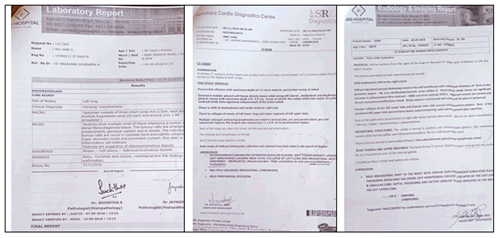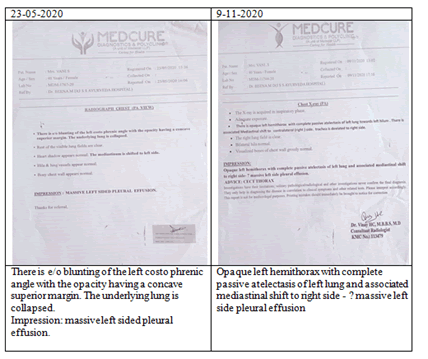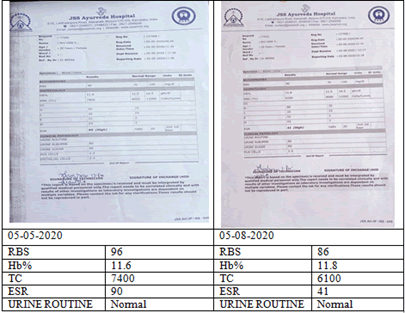Management of Lung Cancer through Ayurveda:A Case Study
Beena MD1* and P Sudhakar Reddy2
1Department of Kayachikitsa, University of JSS Ayurveda Medical College and Hospital, Mysuru, Karnataka, India
2Department of Swasthavritta, University of JSS Ayurveda Medical College and Hospital, Mysuru, Karnataka, India
- *Corresponding Author:
- Beena MD, Department of Kayachikitsa, University of JSS Ayurveda Medical College and Hospital, Mysuru, Karnataka, India, Tel: 9538367282; E-mail: drpbsreddy@yahoo.com
Received date: May 02, 2022, Manuscript No. IPMCRS-22-12888; Editor assigned date: May 05, 2022, Pre QC No. IPMCRS-22-12888 (PQ); Reviewed date: May 20, 2022, QC No. IPMCRS-22-12888; Revised date: July 04, 2022, Manuscript No. IPMCRS-22-12888 (R); Published date: July 12, 2022, DOI: 10.36648/2471-80 41.8.7. 235
Citation: Beena MD, Reddy PS (2022) Management of Lung Cancer through Ayurveda–A Case Study. Med Case Rep Vol:8 No:7
Abstract
The prevalence of Lung cancer is accounting for an estimated 2 million diagnoses and 1.8 million deaths and it is the leading cause of global cancer incidence and mortality. Neoplasms of the lungs are the second most common cancer diagnosis in men and women, after prostate and breast cancer, respectively. Lung cancer incidence is rising globally with increasing access to tobacco and industrialization in developing nations. Regarding the age factor the average age of diagnosis is 70 years old. Because of tobacco consumption men are accounting to prone to get lung cancer, which largely reflects differences in, but women are largely more susceptible due to higher proportions of epidermal growth factor receptor mutations and the effects of estrogen. Family history of lung cancer increases risk by 1.7-fold, with a greater risk among first-degree relatives. About 90% of lung cancer accounted to Tobacco smoking which is largely preventable cause of death worldwide and continued consumption is projected to increase global cancer incidence, particularly in developing nations. Second-hand or positive smoke among children and spouses has likewise been implicated. Other factors like occupational hazards such as asbestos and environmental exposures such as air pollution, arsenic, and HIV and TB infection have all been implicated in lung carcinogenesis, while cannabis smoking, electronic cigarettes, heated tobacco products, and COVID-19 have been hypothesized to increase risk. Even though in Ayurveda there is no direct reference of this disease, but it can be correlated with Kshataja anad Kshayaja kasa at the symptomatic level. Present case of Adenocarcinoma of lung-stage IV has been managed with classical Ayurveda treatment protocol and there was a marked improvement in symptoms and also noted improvement of quality of life.
Keywords
Lung cancer; Kshataja Kasa; Sadyovirechana; Shivagutika
Introduction
Neoplasms of the lungs are the leading cause of cancer incidence and mortality worldwide 1. Lung cancer is divided based on the cell of origin into Small-Cell Lung (SCLC) and Non-Small Cell Lung Cancers (NSCLC), the latter of which is further divided. According to the 2015 WHO classification, the most common types of lung cancer include adenocarcinoma (cancer of glandular cells), Squamous Cell Carcinoma (SCC), and neuroendocrine cancers such as Small Cell Carcinoma (SCLC), Large Cell Neuroendocrine Carcinoma (LCNEC), and carcinoid2. Carcinoid tumors are cancers of well-differentiated neuroendocrine cells (Kulchitsky cells), while SCLC also arises from poorly differentiated neuroendocrine cells, resulting in rapid metastasis, and poorly responsive to therapy, and poor prognosis. Squamous cell and small cell cancers are more likely to be centrally located and associated with a history of smoking, especially among men. Adenocarcinoma is more likely to arise in women and those without a smoking history, they arise peripherally, and test positive for targetable driver mutations such as Epidermal Growth Factor Receptor (EGFR), Anaplastic Lymphoma Kinase (ALK), BRAF (B-RAF proto-oncogene) and ROS13.
According to the latest GLOBOCAN estimates, 2,094,000 new cases of lung cancer were diagnosed globally in 2018, making lung cancer the leading cancer incidence worldwide. With an estimated 1,369,000 cases, lung cancer is the second most common cancer in men, after prostate cancer, and the second most common cancer in women, after breast cancer, with 725,000 cases. The age standardized cumulative lifetime risk of diagnosis of lung cancer is 3.8% among men and 1.77% among women 4 and 5.
India is the second largest consumer and third largest producer of tobacco in the world. Approximately 28.6% of the Indian population uses tobacco products (42.4% men and 14.2% women), accounting for an estimated 267 million tobacco users in the Country. In India, lung cancer accounts for 5.9% of all cancers and 8.1% of all cancer-related deaths. The prevalence of smoking in patients with lung cancer is nearly 80%.6 [1].
In Ayurveda this condition of Ca of Lung-Adenocarcinoma-stage-IV is can be correlated with Kshataja kasa and Kshayaja kasa at the symptomatic level. In present case study the classical Ayurvedic management protocol has been carried out for the subject diagnosed as Ca Lung-Adenocarcinoma-Stage IV.
Case Presentation
History: A 39 years female approached to the hospital with complaints of kasa (cough), moderate to severe shola (pain) in the left side of the chest and back, swasa kruchrita (difficulty in breathing) very often since 1 year 6 months. Complaints of weight loss of about 12 kgs within I year 6 months along with dourbalya (generalized weakness). Also complaints of loss of appetite–takes very little quantity of food and loss of sleep due to discomfort and pain in the right side of the chest c/o mild fever off and on. Patient started with dry cough initially one and a half year ago which gradually increased and disturbed more in the night along with pain, heaviness and stiffness in the left side of the chest. No history of blood stained sputum. Patient developed difficulty in breathing even with mild Exertion [2]. Also developed loss of appetite, loss of weight and which was evaluated and diagnosed as a case of Adenocarcinoma of lung with mediastinal lymph node metastasis. The patient was on modern medicine for symptomatic treatment. As the patient was not interested in modern medicine line of cancer treatment and was having advanced stage of the disease, started with spiritual kind of activities like pooja, homa, havana (Performing religious rituals) etc., for about 1 year and later approached our hospital for Ayurveda treatment with above symptoms (Figures 1-3).
Investigations
Materials and Methods
Treatment protocol
Patient approached to our hospital on 5-5-2020 with the above said complaints. After thorough examinations, investigations, by assessing the dosha-dooshya involvement, Nidana (etiology) and Lakshanas (symptomatology) the condition was correlated to Kshataja (cough due to injury) and Kshayaja (cough due to degeneration of tissues) Kasa mentioned in the classics [3].
In Both Kshayaja and Kshatajakasa the nidanas mentioned as per the Brihatrayis (Great trio) are Ativyavaya, Atibharavahana, Atiadhwa (excessive sexual indulgence, lifting heavy weight, walking), intake of Vishama (faulty), Satmya (unwholesome) Ahara (food), having hatredness, grief and having the habit of Vega nigraha (suppression of natural urges) leading to vata pradhana tridosha janya (Tridosha vitiation) ksahta (injury) and kshaya (tissue degeneration) initially in the Uras (chest) and later seen in the whole body if not treated properly.
Here the prakruti (body constitution)of the patient is vata pitta (vata predominant) and gives the history of some of the etiological factors like very less intake of food with irregular timings, most of the days taking dry bakery items, often lifting heavy weights, more of irritative nature with stressful life which all lead to rukshata (dryness) of the body, agnimandya (altered appetite) and leading to increase of vatadosha followed by the vitiation of pitta and kapha resulting in kshataja and kshayaja in the Uras initially and later to the whole body with lakshanas like Agnimandya (loss of appetite), dhatu kshaya (loss of weight), shushkakasa (dry cough), parswashula (pain in the left chest and flanks), swasa (breathlessness), Jwara (repeated fever), Dourbalya (generalized weakness).
By considering all these aspects the following protocol was framed. Initially administered Mridu Shodhana 9 (mild purgative therapy) for three days with Gandharvahastadi Erandataila 1030 ml with 10 ml Gomutra11 after assessing the koshtha (nature of bowel) of the patient. This was followed by Rasayana therapy in the form of shivagutika 12 (2 g) one tablet daily three times after food. The patient was also given with other drugs like DASHAMULA KATUTHRAYAM KASHAYA 13, SWASAKUTHARA RASA 14, Jeerakadi Leham 15, Shatavari Leham 16 according to the symptoms. Mridu Shodhana was repeated once in every 3 months.
Results
The assessment was done every 15 days and it was found to be very much encouraging in terms of symptomatic relief, quality of life and life expectancy [4].
After 15 days of medication the patient showed about 60% reduction in the cough, 40% reduction in right sided chest pain, also improved with appetite. Sleep also improved well with occasional disturbances. At the end of the third month patient got overall 80-90% relief of all the symptoms. Kasa, Swasakrichrita, Agnimandya, Aruchi reduced by 70% while Parswa shula reduced to 90%. Patient doesn’t have fever after taking the medication which was observed previously. Patient had history of weight reduction about 12 kg within 1 year 6 months which was well maintained (43 kgs) during treatment period of 1 year 8 months. The general health condition measured in the performance status Karnofsky scale was 70 initially (cares for self, unable to carry on normal activities or do active work), which was improved to 100% (Normal, no complaints, no evidence of disease) after 3 months.
The patient was on follow up till November 2021 (i.e., for about 1 year 6 months) without specific complaints related to the disease, and was able to do all the routine house hold activities.
Discussion
As per the studies the possible survival benefit compared to expect median survival as per the extent of disease without any anti-cancerous medication is said to be 7.15 months17. Wherein this patient survived for 1 year 6 months with good quality of life. The initial sufferings like loss of weight, repeated fever, loss of appetite, cough, breathlessness, pain in the left side of the chest and generalized weakness has markedly reduced [5].
The treatment protocol was framed based on the line of treatment of both Kshataja and Kshayaja Kasa where both the treatment principles aim towards Mridu Shodhana (mild purificatory therapy) and Brihmana Chikitsa (nourishing therapy).
The treatment principle for Kshataja Kasa as per Charaka Samhita is Madhura and Jeevaniya Aushadha Prayoga (administration of drugs having sweet taste and which are nourishing in quality) and Bala MamsaVivardhana Ahara and Aushadha (drugs and foods which gives strength to the body and nourishes muscles). Also to follow the line of treatment mentioned for Pittaja Kasa like Mridu Shodhana and Brihmana Chikitsa19. Similarly the treatment principle for Kshayaja Kasa is Agnideepana and Brihmana Chikitsa. And in Bahudosha (excessive vitiation of dosha) condition to give Mridu Virechana (Mridu Shodhana). In both conditions of Kasa dhatu kshaya is very evident clinical feature and hence the treatment principles like Mridu Shodhana to relieve the Srotorodha (obstruction of the channels) are adapted followed by Brihmana Chikitsa.
The same principle was adapted in the present case and started with Mridu Shodhana with GandharvahastadiErandaTailam along with Gomutra.
The Gandharvahastadi erandatailam is Madhura, Katu, Vata-Kaphahara, Pittala (Yogaratnakara), Sookshma, Teekshna, Sara, Snigdha, Srotovishodhana, twachya, vrushya, vayahsthaapi, Yoni vishodhana, medha-smrithi-balakara
In the classics Gomutra prayoga (cows urine with selected drugs) has been mentioned in various advanced disorders like Jalodara (ascites), Pandu (anaemia), Arshas (haemorrhoids), specially as Srotoshodhaka because of its Kshara-ksharanaguna (Alkaline-scraping nature), Ushnaveerya (hot potency), Agnideepana (improves digestion).
The administration of Gandharvahastadi Erandataila along with Gomutra helps in Vatanulomana which is very much essential in all the cancerous conditions as Vata is abnormally deranged which in turn leads to the excessive proliferation of tissues. Both Gandrvahastadi Eranda taila and Gomutra are Srotoshodhaka by virtue of its Rasa (taste), Guna (property), Veerya (potency) and Karma (action) [6].
As per the classics Shodhana therapy is a best practice before giving any Rasayanas for its better absorption and action. Here the condition is an advanced case Lung Carcinoma hence after assessing the bala (Strength) of the patient a mild purificatory (Mridu Shodhana) therapy was given prior to the administration of the Rasayana drug- Shivagutika.
The Shivagutika is a polyherbo-mineral formulation. The main ingredient is Shilajitu (Black Bitumen) along with more than 50 herbal drugs like Triphala, Dashamula, Guduchi, Patola, Bala, Yastimadhu, Gomutra (cow’ s urine), Gokshira (cow’s milk), Kakolyadigana drugs, Shatavari, Narikela, Karkatasringi, Trikatu, Talisapatra, Vidari, Vamsalocana, Trijata, Nagakesara, Tilataila, Ghrita (cow’s ghee), Madhu (honey). It is a Rasayana (Rejuvenative) drug, having a wide range of benefits in chronic and advanced diseases like Vatarakta(gouty arthritis), Rajayakshma (chronic respiratory disorders), Jwara (chronic fever), Pleeharoga (disorders of spleen), Arshas (haemorrhoids), Pandu (anaemia), Hridroga (cardiac ailments), Grahani (IBS/Sprue syndrome), Gulma (abdominal tumors), Hikka (hiccough), Kasa (chronic cough), Swasa (dyspnoea), Udara (ascites), Kushtha (chronic skin ailments), Switra (leukoderma), Kshaya (phthisis), Shosha (emaciation), Unmada (mental disorders), Apasmara (epilepsy), Mukharogas (oral cavity diseases), Shiroroga (diseases related to the head), Atisara (loose stools), Asrigdhara (menorrhagia), Kamala (jaundice), Prameha (diabetes mellitus), Yakritodara (liver disorders), Arbuda (cancerous conditions), Vidradhi (abscess), Atisthoulya (obesity), Sleepada (elephantiasis). Also alleviates different types of poisonous effects from the body. It promotes the strength, aphrodisiac, power, virility and lustre. It improves memory, intellect, immunity, clarity of sense organs and provides maximum longevity.
There are research studies on the anti-cancerous properties of Shivagutika stating that the mineral pitch (Shilajit) induces apoptosis and inhibits proliferation via modulating reactive oxygen species in hepatic cancer cells.
Conclusion
The classical approach of Mridushodhana and Rasayana therapy by Shivagitika helped in relieving the signs & symptoms improved the quality of life and increased the life span to a great extent in advanced stage of Adenocarcinoma of lung. Further clinical studies are needed to prove the efficacy of classical approach in the treatment of Lung carcinoma statistically and scientifically.
References
- Fitzmaurice Ch, Abate D, Abbasi N (2019) Global, regional, and national cancer incidence, mortality, years of life lost, years lived with disability, and disability-adjusted life-years for 29 Cancer groups, 1990 to 2017: a systematic analysis for the global burden of disease study. JAMA Oncol 5:1749-1768
[Crossref] [Google Scholar] [Indexed]
- Travis WD, Brambilla E, Nicholson AG, Yatabe Y, Austin JH, et al. (2015) The 2015 World Health Organization classification of lung tumors: impact of genetic, clinical and radiologic advances since the 2004 classification. J Thorac Oncol 10:1243-1260
[Crossref] [Google Scholar] [Indexed]
- Denisenko TV, Budkevich IN, Zhivotovsky B (2018) Cell death-based treatment of lung adenocarcinoma. Cell Death Dis 9:117
[Crossref] [Google Scholar] [Indexed]
- Bray F, Ferlay J, Soerjomataram I, Siegel RL, Torre LA, et al. (2018) Global cancer statistics 2018: GLOBOCAN estimates of incidence and mortality worldwide for 36 cancers in 185 countries. CA Cancer J Clin 68:394-424
[Crossref] [Google Scholar] [Indexed]
- Balachandran P, Govindarajan R (2005) Cancer-an ayurvedic perspective. Pharmacol Res 51:19-30.
[Crossref] [Google Scholar] [Indexed]
- Debnath PK, Chattopadhyay J, Mitra A, Adhikari A, Alam MS, et al. Adjunct therapy of Ayurvedic medicine with anti-tubercular drugs on the therapeutic management of pulmonary tuberculosis. J Ayurveda Integr Med 3:141-149
[Crossref] [Google Scholar] [Indexed]

Open Access Journals
- Aquaculture & Veterinary Science
- Chemistry & Chemical Sciences
- Clinical Sciences
- Engineering
- General Science
- Genetics & Molecular Biology
- Health Care & Nursing
- Immunology & Microbiology
- Materials Science
- Mathematics & Physics
- Medical Sciences
- Neurology & Psychiatry
- Oncology & Cancer Science
- Pharmaceutical Sciences



